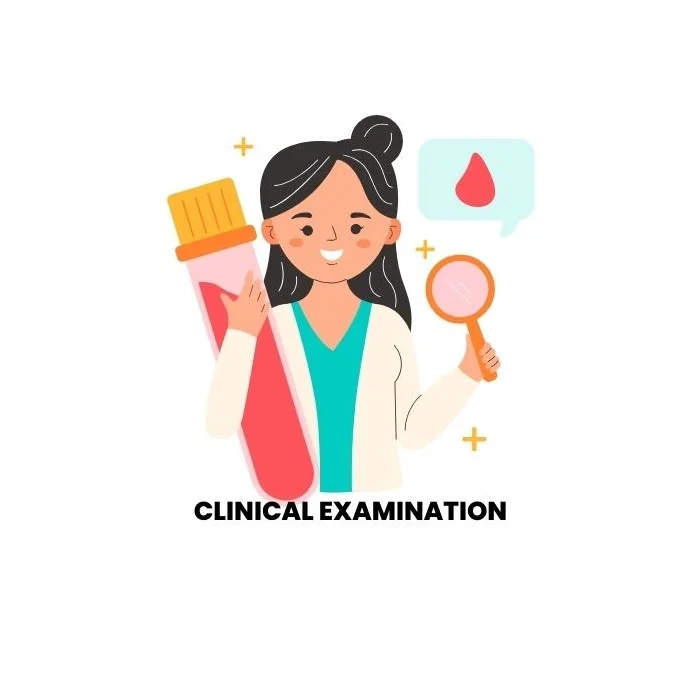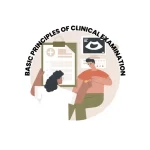Clinical examination is at the heart of medical practice, where doctors use their senses to observe and understand a patient’s health.
This guide simplifies the complexities of clinical examination, providing clear definitions and relatable examples.
Whether you’re a medical student, a seasoned doctor, or someone curious about healthcare, this post is your window into the world of clinical examination.
HERE ARE THE BASIC PRINCIPLES OF CLINICAL EXAMINATION.

Table of Contents
ToggleSymptoms and Complaints: Understanding the Patient’s Perspective
- Patients come to doctors with health issues, expressed as “COMPLAINTS.”
- These complaints, termed “SYMPTOMS,” are the patient’s way of describing what’s wrong.
- For example, a patient complaining of a persistent cough is presenting a symptom.
WHAT IS CONCEPT OF HEALTH AND DISEASE?
Taking the Patient’s History: The Art of Inquiry
- After listening to the patient’s symptoms, doctors delve deeper into the patient’s medical history.
- This step, known as “TAKING THE HISTORY,” helps contextualize the illness.
- Effective communication and empathy are vital to extract accurate information.
READ A DETAILED POST ON PHYSICAL EXAMINATION METHODS FOR MEDICAL STUDENTS BY FOLLOWING THE LINK.
Q: What are the key skills required for an effective clinical examination?
A: Effective clinical examination requires a combination of keen observation, strong communication skills, empathy, and a deep understanding of anatomy and physiology.
Physical Examination: Decoding Clinical Signs
- Doctors examine patients to detect signs of illness and determine their causes.
- What doctors observe during this process is referred to as “SIGNS.”
- Signs should be clear and reproducible, making them reliable indicators of a patient’s condition.
Q: How do doctors differentiate between symptoms and signs during an examination?
A: Symptoms are what patients describe, while signs are what doctors observe. For example, a patient’s description of pain is a symptom, while a red, swollen area on their skin is a sign.
Syndromes: Where Signs and Symptoms Unite
- Sometimes, a set of signs and symptoms consistently appear together, forming a “SYNDROME.”
- Recognizing syndromes aids in diagnosing specific medical conditions.
Q: Can you provide an example of a medical syndrome and how it aids in diagnosis?
A: Irritable Bowel Syndrome (IBS) is a classic example. It involves symptoms like abdominal pain, bloating, and changes in bowel habits. When doctors consistently encounter this combination of symptoms, it suggests IBS as a diagnosis.
Special Investigations: Going Beyond the Surface
- In complex cases, doctors may need additional information about a patient’s condition.
- Special investigations, such as X-rays, cerebrospinal fluid analysis, or biopsies, offer deeper insights.
Q: What is the role of special investigations in clinical examination, and when are they necessary?
A: Special investigations, like X-rays or biopsies, provide additional information beyond what a physical examination reveals. They are necessary in complex cases or when deeper insights are required for accurate diagnosis.
Diagnosis: Naming the Illness
- Based on collected information, doctors establish a diagnosis, specifying the cause, effect, and extent of the illness.
- Diagnosis serves as the foundation for treatment decisions.
Q: How can variation in healthcare observations impact clinical examination?
A: Variation is common in healthcare, and there’s no rigid line between normal and abnormal. It’s crucial to evaluate observations in the context of each patient’s unique factors, including age, gender, and overall health.
Differential Diagnosis: Weighing Possibilities
- Doctors often consider multiple potential diagnoses with similar symptoms.
- The process of evaluating these possibilities is known as “differential diagnosis.”
Q: What are some common challenges in differential diagnosis?
A: Differential diagnosis can be challenging when multiple conditions share similar symptoms. Doctors must carefully consider each possibility, weigh the evidence, and use their clinical judgment.
Palliative and Curative Treatment: Addressing Symptoms and Causes
- Palliative treatment provides relief from symptoms, while curative treatment targets the root cause of the illness.
- Not all diseases are curable, so palliation plays a crucial role in patient care.
Q: Are palliative treatments only for incurable diseases?
A: Palliative treatments provide relief from symptoms and can be used in both curable and incurable conditions. Their goal is to improve a patient’s quality of life.
Monitoring Progress: Tracking the Journey to Recovery
- Throughout treatment, doctors assess the patient’s progress.
- Lingering signs may persist even after symptom relief, requiring continued monitoring.
Prognosis: Predicting the Future
- Doctors offer patients a prognosis, predicting the future course of the disease and expected outcomes.
Q: What is the significance of a prognosis in clinical examination?
A: A prognosis helps patients and healthcare providers understand the expected course of an illness, potential outcomes, and the likelihood of recovery.
Preventive Methods: Safeguarding Against Recurrence
- Measures are taken to prevent disease recurrence in the patient and its spread in the community.
Autopsy: Learning from Failures
- When a patient succumbs to a disease, a thorough examination of the body, known as an “autopsy,” provides insights into disease processes and treatment failures.
The Doctor-Patient Relationship: Trust and Sympathy
- Building trust and a strong doctor-patient relationship is essential for obtaining accurate information during examination. – Doctors should approach patients with empathy and respect, fostering open communication.
Q: How important is the doctor-patient relationship in clinical examination?
A: Building trust and maintaining a strong doctor-patient relationship is essential. It fosters open communication and encourages patients to share accurate information about their symptoms and medical history.
The Art of Clinical Examination: Technique and Practice
- Learning the technique of clinical examination is essential. – Mastery comes through practice and guidance from experienced teachers. – Remember, it’s a lifelong learning journey.
Q: How can healthcare professionals continue to improve their clinical examination skills?
A: Continuous learning and practice are key. Seeking guidance from experienced mentors, attending workshops, and staying updated with medical advancements are all important steps.
Variation: Normal or Abnormal?
- In healthcare, variation is common, making it challenging to define precise boundaries between normal and abnormal. – Always evaluate observations in the context of anatomy, physiology, and individual factors.
LEARN ABOUT WHY AVOIDING THE TERM ‘NORMAL’ IS ESSENTIAL IN CLINICAL EXAMINATION? BY FOLLOWING THE LINK.
Conclusion
Clinical examination is both a science and an art.
It involves keen observation, compassionate care, and a deep understanding of the human body.
By following the systematic process outlined in this guide, medical professionals and curious minds can gain a deeper appreciation of the vital role clinical examination plays in healthcare.
Remember, each patient encounter offers a unique opportunity for learning and understanding the intricate world of medicine.
Read a detailed post on TOLLE CAUSAM IN HOMOEOPATHY which means “Treat the Cause”.













Leave a Reply